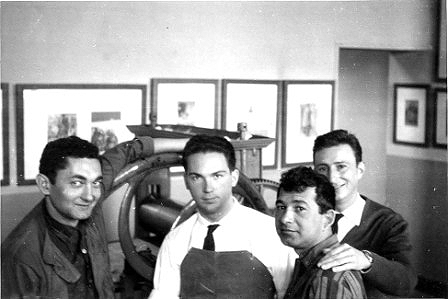The piece of the month of January 2014
CARNIVAL OF LANZ, AN ENGRAVING BY JESÚS LASTERRA
José María Muruzábal del Solar
PhD in Art History
Jesús Lasterra (Madrid, 1931 - Pamplona, 1994) is one of the greatest exponents of Navarrese painting, and also of engraving, of the 20th century. He began his training at the School of Arts and Crafts and at Javier Ciga's academy, all in Pamplona. From 1955 he studied Fine Arts at programs of study in San Fernando de Madrid, where he worked intensively on engraving. He lived in Madrid until 1969, when he moved permanently to Pamplona, from where he never left.
His first contact with the learning of the technique was when he enrolled in San Fernando in engraving, for the academic year 1959/60, completing three courses of engraving. His teacher there was Luis Alegre. He took one more course, devoted to intaglio engraving, during the 1962/63 academic year. This period was particularly fruitful in the production of engravings. At that time he produced 20 works, which accounted for 45% of his total output, depicting themes of Castile, Pamplona and Estella.

class engraving at the Real Academia de Bellas Artes de San Fernando, 1962
Zachrisson, Eslava, Yrisarri and Lasterra
Around 1967/68 he began another period in his production, which we can consider his artistic maturity in technique. He now achieves very elaborate, complex works with which he will reach his highest distinctions, especially the themes of the Lanz Carnival. After that, Lasterra stopped recording for 20 years. At the end of the eighties, the artist set up an engraving workshop with two of his students, where he produced his last works in 1988. These engravings are effective, correct, but they do not make us forget his previous works, with themes of Pamplona and, once again, of the Lanz Carnival.
In the different modes of engraving, 44 works are documented. Most of the engravings are etchings, a technique in which Lasterra became a master. There are a few lithographs, three in particular, but without much continuity. As the artist matured in the technique, his etchings became more complicated in terms of execution. Other technical possibilities were also added, such as aquatints, resins, etc. In his mature works, especially those dedicated to the Lanz Carnival, he added other elements such as lace or lace trimmings within the plate in order to achieve different qualities in the final work.
Within Jesús Lasterra's production of engravings, the themes dedicated to the Lanz Carnival are essential. We dare say that we are looking at the artist's great aesthetic finding . This is a theme that is quite often repeated in his engravings, although it is very rarely dealt with in his oil paintings. These engravings were made in two stages, the first ones at the end of the 1960s and the others at the end of the 1980s. award There are eight engravings with this theme; the main one is "Carnaval de Lanz", reproduced here, with which he won the National "Castro Gil" engraving prize in 1969. There are also various drawings and sketches on the topic, especially in sanguine.
Lanz Carnival, by Jesús Lasterra
Etching and aquatint. P/A 10/12. 50 x cm
nationalaward of engraving "Castro Gil" in 1969
The degree scroll Carnaval de Lanz is Lasterra's best-known work in the engraving technique. It is an etching and aquatint work, in which he added other elements such as lace or lace trimmings within the plate to achieve different qualities in the final work, and which depicts the bandit's walk through the crowd. This is how Carlos Areán's critical judgement put it, "qualities like lace or gauze, which reticulate the space and manage to combine the finest almost noucentista sensibility with a vigour and a full and counterbalanced spatial arrangement, very typical of the attitudes which in our time try to capture the burden of a life which is sometimes obliged to reflect on itself".
This ancestral festival, with its mysterious atmosphere of nightfall, its almost mythical characters, music and fire, was an ideal place to capture all the aesthetic and expressive possibilities that Lasterra possessed, as he described it in his work topic . These are compositions with a crowded space, with a certain agglomeration of elements, with energetic backlighting. These are works with very few open visual fields, in which the space is intermingled with elements that give a sensation of thickness and intensity, like the carnival festival itself; but they are extremely expressive works, accomplished and definitive, which serve to consecrate an artist.
Honey Otxin, by Jesús Lasterra, 1968
Etching and aquatint, 64 x cm
bibliography
-MURUZÁBAL DEL SOLAR, J. M., El pintor Jesús Lasterra, Pamplona, Ed. Fecit, 2005.
-MURUZÁBAL DEL SOLAR, J. M. and MURUZÁBAL DEL VAL, J. M., "Engravings by Jesús Lasterra", Pregón Siglo XXI Magazine, 17-18 (June - December 2001).
-MURUZÁBAL DEL SOLAR, J. M. "El pintor Jesús Lasterra" in Catalog exhibition anthology in conference room Castillo de Maya de Pamplona, Pamplona, Ed. CAN, 2005.
